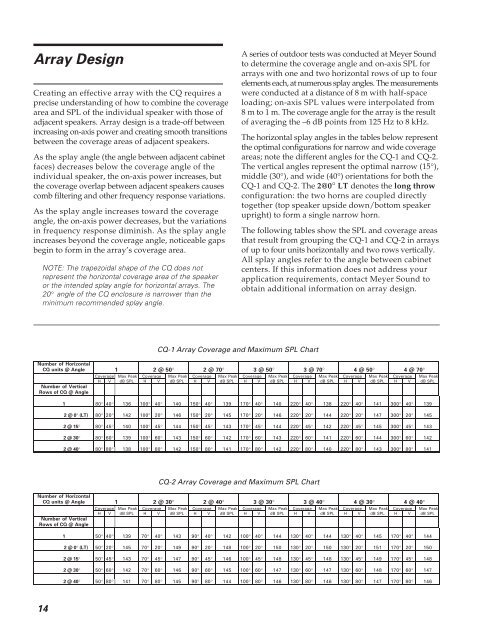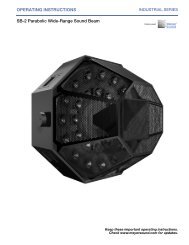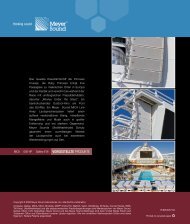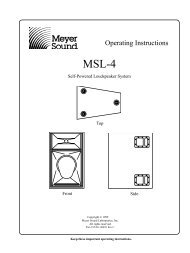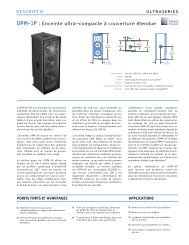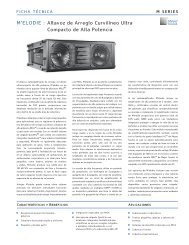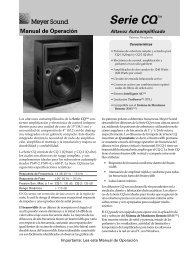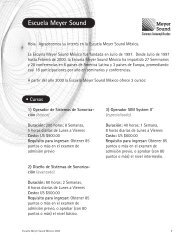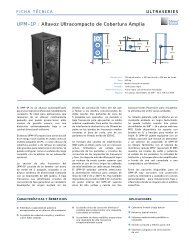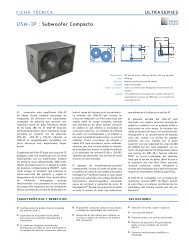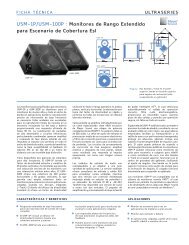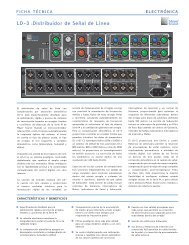Operating Instructions CQ Series - Meyer Sound Laboratories Inc.
Operating Instructions CQ Series - Meyer Sound Laboratories Inc.
Operating Instructions CQ Series - Meyer Sound Laboratories Inc.
Create successful ePaper yourself
Turn your PDF publications into a flip-book with our unique Google optimized e-Paper software.
Array Design<br />
Creating an effective array with the <strong>CQ</strong> requires a<br />
precise understanding of how to combine the coverage<br />
area and SPL of the individual speaker with those of<br />
adjacent speakers. Array design is a trade-off between<br />
increasing on-axis power and creating smooth transitions<br />
between the coverage areas of adjacent speakers.<br />
As the splay angle (the angle between adjacent cabinet<br />
faces) decreases below the coverage angle of the<br />
individual speaker, the on-axis power increases, but<br />
the coverage overlap between adjacent speakers causes<br />
comb filtering and other frequency response variations.<br />
As the splay angle increases toward the coverage<br />
angle, the on-axis power decreases, but the variations<br />
in frequency response diminish. As the splay angle<br />
increases beyond the coverage angle, noticeable gaps<br />
begin to form in the array’s coverage area.<br />
NOTE: The trapezoidal shape of the <strong>CQ</strong> does not<br />
represent the horizontal coverage area of the speaker<br />
or the intended splay angle for horizontal arrays. The<br />
20° angle of the <strong>CQ</strong> enclosure is narrower than the<br />
minimum recommended splay angle.<br />
14<br />
<strong>CQ</strong>-1 Array Coverage and Maximum SPL Chart<br />
<strong>CQ</strong>-2 Array Coverage and Maximum SPL Chart<br />
A series of outdoor tests was conducted at <strong>Meyer</strong> <strong>Sound</strong><br />
to determine the coverage angle and on-axis SPL for<br />
arrays with one and two horizontal rows of up to four<br />
elements each, at numerous splay angles. The measurements<br />
were conducted at a distance of 8 m with half-space<br />
loading; on-axis SPL values were interpolated from<br />
8 m to 1 m. The coverage angle for the array is the result<br />
of averaging the –6 dB points from 125 Hz to 8 kHz.<br />
The horizontal splay angles in the tables below represent<br />
the optimal configurations for narrow and wide coverage<br />
areas; note the different angles for the <strong>CQ</strong>-1 and <strong>CQ</strong>-2.<br />
The vertical angles represent the optimal narrow (15°),<br />
middle (30°), and wide (40°) orientations for both the<br />
<strong>CQ</strong>-1 and <strong>CQ</strong>-2. The 2@0° LT denotes the long throw<br />
configuration: the two horns are coupled directly<br />
together (top speaker upside down/bottom speaker<br />
upright) to form a single narrow horn.<br />
The following tables show the SPL and coverage areas<br />
that result from grouping the <strong>CQ</strong>-1 and <strong>CQ</strong>-2 in arrays<br />
of up to four units horizontally and two rows vertically.<br />
All splay angles refer to the angle between cabinet<br />
centers. If this information does not address your<br />
application requirements, contact <strong>Meyer</strong> <strong>Sound</strong> to<br />
obtain additional information on array design.<br />
Number of Horizontal<br />
<strong>CQ</strong> units @ Angle 1 2 @ 50° 2 @ 70° 3 @ 50° 3 @ 70° 4 @ 50° 4 @ 70°<br />
Coverage Max Peak Coverage Max Peak Coverage Max Peak Coverage Max Peak Coverage Max Peak Coverage Max Peak Coverage Max Peak<br />
H V dB SPL H V dB SPL H V dB SPL H V dB SPL H V dB SPL H V dB SPL H V dB SPL<br />
Number of Vertical<br />
Rows of <strong>CQ</strong> @ Angle<br />
1 80° 40° 136 100° 40° 140 150° 40° 139 170° 40° 140 220° 40° 138 220° 40° 141 300° 40° 139<br />
2 @ 0° (LT) 80° 20° 142 100° 20° 146 150° 20° 145 170° 20° 146 220° 20° 144 220° 20° 147 300° 20° 145<br />
2 @ 15° 80° 45° 140 100° 45° 144 150° 45° 143 170° 45° 144 220° 45° 142 220° 45° 145 300° 45° 143<br />
2 @ 30° 80° 60° 139 100° 60° 143 150° 60° 142 170° 60° 143 220° 60° 141 220° 60° 144 300° 60° 142<br />
2 @ 40° 80° 80° 138 100° 80° 142 150° 80° 141 170° 80° 142 220° 80° 140 220° 80° 143 300° 80° 141<br />
Number of Horizontal<br />
<strong>CQ</strong> units @ Angle 1 2 @ 30° 2 @ 40° 3 @ 30° 3 @ 40° 4 @ 30° 4 @ 40°<br />
Coverage Max Peak Coverage Max Peak Coverage Max Peak Coverage Max Peak Coverage Max Peak Coverage Max Peak Coverage Max Peak<br />
H V dB SPL H V dB SPL H V dB SPL H V dB SPL H V dB SPL H V dB SPL H V dB SPL<br />
Number of Vertical<br />
Rows of <strong>CQ</strong> @ Angle<br />
1 50° 40° 139 70° 40° 143 90° 40° 142 100° 40° 144 130° 40° 144 130° 40° 145 170° 40° 144<br />
2 @ 0° (LT) 50° 20° 145 70° 20° 149 90° 20° 148 100° 20° 150 130° 20° 150 130° 20° 151 170° 20° 150<br />
2 @ 15° 50° 45° 143 70° 45° 147 90° 45° 146 100° 45° 148 130° 45° 148 130° 45° 149 170° 45° 148<br />
2 @ 30° 50° 60° 142 70° 60° 146 90° 60° 145 100° 60° 147 130° 60° 147 130° 60° 148 170° 60° 147<br />
2 @ 40° 50° 80° 141 70° 80° 145 90° 80° 144 100° 80° 146 130° 80° 146 130° 80° 147 170° 80° 146


